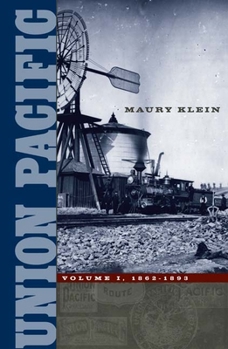Union Pacific: Volume I, 1862-1893 Volume 1
(Book #1 in the Union Pacific Series)
Select Format
Select Condition 
Book Overview
The Union Pacific Railroad is renowned as America's first transcontinental railroad and is one of the strongest companies in the railroad industry today. The laying of the golden spike in Promontory, Utah, in 1869 marked not only the opening of the continent to settlement but also the transformation of the United States from an agricultural nation to an industrial one.Maury Klein, America's foremost railroad historian, re-creates the powerful personalities and dramatic events that led to the construction of this legendary railroad. Fully illustrated with over one hundred historic photographs and maps, Union Pacific details the feat of engineering and human strength that conquered the terrain of the desert and mountains and also the colorful wheelings and dealings that were waged in executive boardrooms in New York and Boston and in the chambers of Congress as dreamers and scoundrels, politicians and patriots forged a pioneering enterprise in transportation. Maury Klein is professor of history at the University of Rhode Island. He is the author of several books, including the Pulitzer Prize finalist The Life and Legend of Jay Gould.
Format:Paperback
Language:English
ISBN:0816644594
ISBN13:9780816644599
Release Date:March 2006
Publisher:University of Minnesota Press
Length:820 Pages
Weight:2.70 lbs.
Dimensions:1.7" x 6.7" x 9.2"
Customer Reviews
3 ratings
How to build, operate, and finance a railroad.
Published by Thriftbooks.com User , 20 years ago
In his two volume work on the UP, Klein devotes the first volume to the building of the railroad and the second volume to the operations and expansion - basically the next hundred years. There are a number of good books out there about the building of the UP. Klein is much better than any of the others that I have read in describing the finances of the railroad and particularly the ambiguities of the financial structure. Credit Mobilier was certainly not a straightforward vehicle for looting profits from an ongoing corporation a la Kozlowski or Ken Lay. These people took enormous risks; many of them ended up losing all their money. None of the people on the UP side (as opposed to the Central Pacific side) ended up making enormous fortunes.Whereas Vol. 1 covers familiar territory well, Vol. 2 explores totally new ground. Operating the railroad for the first 25 years after it was "completed" (it actually didn't stop adding track until well into the 20th Century; not until the 1990s if you count mergers) was at least as difficult and impressive as was building the initial road. The difficulties of making this a profitable enterprise despite legal problems and government interference were enormous. These issues and the personalities of the leaders of the road are explained superbly. I wish there were more books like this about corporate growth and operation.
Klein's Union Pacific Volume 1
Published by Thriftbooks.com User , 25 years ago
I found Klein's fantastic first volume on the history of the Union Pacific in the library of a neighboring town. Klein's history covers both the difficulties encountered in building the railroad and the financial/political scheming that went on back east in New York and Washington. After reading Klein's book, particularly with respect to the fraud and politicing, that one fully understands why railroads were feared and government regulation instituted. I strongly recommend this book to anyone interested in the building of the Transcontinental Railroad and/or early US railroad history. (PS: I also found Volume II to be an excellent continuation of Klein's work.)
History of UP 1862 1894
Published by Thriftbooks.com User , 25 years ago
Professor Klein deals with the turbulent early years with a grace and style not often seen in business history. I had the unique experiance of reading these books in the reverse order, ten years apart, but nothing was lacking in Volume One. Particularly sensitive treatment of the Gould years, and a very cohesive and in depth analysis of the Credit Mobilier fiasco. Klein writes very well; a strong point when dealing with high finance. Great book.






